

![]()

From the late 1920's, Dr. Willy Messerchmitt antagonized Erhard Milch, eventually Hitler's Secretary of State for Aviation, and thus Messerchmitt's company, Bayerische Flugzeugwerke (BFW), could not get much support from the German government.
At one point, the Gestapo even called on Messerchmitt to question him about his contracts with the Romanian government. In 1933, his luck changed, when the Luftwaffe invited BFW to design a sports plane for an upcoming international air race. Messerschmitt, under tight deadlines, based his new aircraft on the work he had done for the Romanian sports plane.
The resulting Bf 108, the forerunner to the 109, flew in February, 1934, with a top speed over 200 MPH. Its performance at the races showed real promise, but due to Milch's influence, the Luftwaffe's request that year for a fighter was given to Focke-Wulf, Arado, and Heinkel, but not to BFW. By 1935, though, Messerchmitt was granted a development contract, something of a gamble. As a development-only contract, it represented a gamble. Milch made it clear that no production contract would follow. Messerchmitt relied on the superior qualities of his design, the Bf 109, to overcome Milch's opposition.
The prototype Bf 109V-1 was ready in August, 1935, Like its predecessor, the Bf 108, it was a low wing, all metal construction monoplane, with flush rivets, leading edge slats, and retractable landing gear. Its single-seat cockpit had a fully enclosed canopy. While none of the developments were revolutionary in 1935, Messerschmitt first put them all together in the Bf 109. Powered by a 695 HP twelve cylinder Rolls-Royce Kestrel engine, the Bf 109V-1 first flew in September of that year.
At first, the Luftwaffe pilots, from Ernst Udet on down, distrusted the aircraft. It seemed frail; its enclosed canopy was disconcerting; it had a very high wing loading; and its narrow track landing gear was prone to failure. (On this last point, their concerns were well founded. Landing gear troubles plagued the 109its entire career.)
But its speed and agility impressed the Luftwaffe skeptics; even Udet came around to support the plane. Even before the results of the competition were known, Messerschmitt pushed on with the second and third models. The Bf 109V-2 was powered by a 610 HP Junkers Jumo 210A but was otherwise similar to the V-1.
The V-3, the third prototype, was the first Bf 109 to be armed, carrying two 7.9mm MG17 machine guns and 1000 rounds of ammunition, as called for in the RLM spec. Otherwise similar to the first two examples, its first flight was delayed until May 1936, due to teething problems with the Jumo 210A engine.
Meanwhile, the Arado and Focke-Wulfe entries had foundered on poor performance and mechanical problems, and Heinkel’s He 112 could not match Messerschmitt’s entrant. Reports of the technologically advanced British Spitfire development added to the Bf 109's favor. Throughout the 1936 trials, the BFW fighter looked better and better, prompting the RLM to order ten Bf 109s. Udet's stunning performance in a Bf 109 at the Rechlin air show confirmed the decision. In front of Generalfeldmarschall Goering and other Luftwaffe brass, Udet intercepted four He 51s in a mock air battle, "destroyed" them, and then turned on a force of bombers and "destroyed" them as well.
In November 1936, the Bf 109V-4 flew. It mounted a third machine gun in the nose and otherwise resembled the V-3.
With production now guaranteed, BFW finished the prototyping with two more airplanes: the Bf 109V-5 and the Bf 109V-6, both equipped with an improved Jumo 210B engine.
With Nazi Germany committed to the Fascist forces in the Spanish Civil War, the Germans rushed these last three pre-production aircraft to Seville in December, 1936. Essentially, the final field-testing of the Bf 109 took place in actual combat, as the German “volunteers” of the Condor Legion immediately began flying missions.
The RLM had ordered 30 production aircraft, designated the Bf 109B. Carrying the latest 680 HP Jumo 210D engine, a wooden two-bladed prop, and only two cowling-mounted guns (the engine-mounted gun had caused overheating), the 109B began to be delivered in February 1937. These too were promptly shipped to Spain. At low altitudes, the maneuverable Russian Polikarpov I-15s and I-16s danced around the 109s; the Condor Legion pilots quickly learned to stay at high altitudes.
Back in Germany, both production and development of the design moved ahead. To augment BFW’s factories, the Fieseler company began license-production at the end of 1937. An improved, metal, variable pitch propeller, licensed by Hamilton Standard, was used in the later Bertha’s, as the Bf 109B was nicknamed. 700 HP Jumo 210G and 210Ga engines with fuel injection and two stage superchargers, powered the next development prototypes, the Bf 109V-7 and Bf 109V-8, respectively. Significantly, the V-8 carried four 7.9mm machine guns. While still equipped with the relatively light rifle-caliber weapons, at this point the Bf 109 began to resemble the heavily armed fighters of WW2. A V-9 variant carried 20mm cannons in the wings, but they proved unreliable.
The Daimler Benz powerhouse engine, the DB 600, powered four later developmental models: the V-10, V-11, V-12, and V-13. The V-13 (equipped with the DB601) set the world speed record in November 1937, at 379.38 MPH.
From March 1938, as soon as the first Claras rolled off the Augsburg assembly lines, they were rushed to Spain. Capable of 290 MPH at altitude, the Bf 109C overmatched its Soviet adversaries in Spain. The C-1 added a pair of wing-mounted 7.9mm guns, included an FuG 7 radio, and visibly increased the radiator intake. Three more experimental models the C-2, C-3, and C-4 tested other, heavier gun configurations.
What is right: Bf 109, Bf-109, BF-109, Bf109, Me 109, Me-109, ME 109, or ME109?
In 1938, during the production of the C version, Messerschmitt's global reputation has grown to the point where the Air Ministry suggested changing his company's name from Bayerische Flugzeugwerke to Messerchmitt A.G.. Subsequent aircraft would be identified with the "Me" prefix; those already in production, the 109, would retain the "Bf" designator. Nonetheless, many people began referring to the "Me 109," including the USAAF; contemporary air combat reports are filled with references to the "Me 109."
In German usage at the time, "Bf 109" was correct. No dash, lower case "f," not "Me 109," and including a space between "Bf" and "109." But confusion persists to this day. Try a web search on "Messerschmitt Me 109." You'll get almost as many hits as with the proper abbreviation.
Daimler Benz’ state-of-the-art DB 600 series promised to be the ideal engine for the Bf 109. Not only was it powerful, but its fuel injection would not stall out during sharp aerial maneuvers, as carburetor systems could. With other programs, notably the He 111 also demanding the 600 series engines, the Bf 109D, “Dora,” was an interim solution, equipped with the Jumo 210 powerplant.
About 200 Doras were built, with subvariants identified with different armaments: D-1 tried the engine-mounted 20mm cannon with no more success than earlier models. D-2 reverted to four 7.9mm guns (two in the wings, two in the cowling). D-3 substituted 20mm cannon in the wings.
 Messerschmitt Bf109E-3 of the Spanish Civil War.
Messerschmitt Bf109E-3 of the Spanish Civil War.
While sources vary on the number and type, most agree that 130-140 Messerschmitt Bf 109’s served in Spain: approximately 4 prototypes, 40+ Berthas, 5 Claras, 35 Doras, and 44 Emils. By early 1939, when the 109E’s arrived, the Republican opposition had nearly collapsed; twenty of these models were left behind for Spain’s air force.
Bf 109 pilots like Werner Moelders and Wolfgang Schellmann distinguished themselves in Spain. Moelders is
Bf 109E - Emil credited with developing the “finger four” formation, which became the standard fighter formation for decades. Moelders scored 14 kills in Spain, the top German ace of that conflict. Over 200 German pilots flew with the Condor Legion, gaining precious combat experience that would serve them well in WW2. See the full list at Luftwaffe Aces of the Spanish Civil War .
Willy Messerschmitt’s promising fighter finally achieved its potential with the Bf 109E variant, powered by the cutting edge DB 601A. The Emil progressed through numerous subvariants. The prototypes Bf 109V-13 through Bf 109V-20 were considered as “E-0” types.
The Bf 109E-1, delivered in early 1939, introduced a three-bladed, variable pitch propeller and twin underwing radiator intakes. It was very fast and arguably the best fighter in the world at that time. By later WWII standards, it was still lightly armed, with four rifle caliber machine guns, two in the cowling and two in the wings.
By September 1939, when Germany attacked Poland, the Luftwaffe had almost 1,000 Bf 109’s in service, mostly “E” models. 200 took part in the Polish campaign, a third of them lost, mainly to ground fire.
During the ensuing “Phony War” on the Western Front, a hapless Luftwaffe pilot set his 109E down on the wrong side of the lines. The Brits rushed the plane back to Britain for a complete evaluation; the aircraft was startlingly superior to the Hawker Hurricane under all conditions and superior to the Supermarine Spitfire at lower altitudes. Today this aircraft sits on display at the RAF Museum at Herndon.
With a top speed of 350 miles per hour at altitude, the Bf 109E-3 took good advantage of the latest Daimler Benz motor, the 1200 horsepower DB 601Aa. It incorporated a stronger canopy and more cockpit armor. It upgraded the E-1’s weaponry by replacing the wing machine guns with MG-FF 20 millimeter cannons. Interestingly, the E-3 weighed under 6,000 pounds, less than half the weight of an American P-47. (Note: the Bf 109E-2 never reached production.)
With an improved, softer recoil mechanism, the MG-FF/M cannon which appeared on the Bf 109E-4 distinguished the E-4 from the earlier E-3. The MG-FF/M could also fire highly effective explosive shells.
The “Me 109” outclassed its opponents in the blitzkrieg against France of May 1940. Needing a fighter-bomber, Jagdbomber or Jabo, the Luftwaffe fitted some Emils with bomb racks and they effectively struck Channel shipping and land targets. Jabo modifications to the 109 were denoted with a “/B” suffix, for example, Bf 109E-1/B and Bf 109E-3/B.
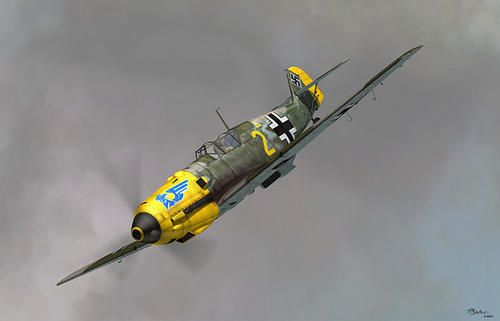
Messerschmitt Bf109E-1
For three months, the Bf 109 engaged the Hurricanes and Spitfires of the RAF in a momentous struggle for air superiority over the Great Britain
The airplane performed as required, but the distances from bases and the need to use the Messerschmitt in a bomber escort role took their toll. Early on the Bf 109 ranged freely while the Me 110's shepherded the bombers, but when the "shepherds" were mauled as badly as their flock by the RAF wolves, the Bf 109's were called on. Downed German pilots who parachuted safely, nonetheless, were lost for the duration as POWs; British pilots who hit the silk promptly returned.
By the end of October 1940, the British had lost 1,149 airplanes, mostly fighters. The Luftwaffe lost almost 1,800 aircraft, one third of them Bf 109s. For the first time, Hitler had been checked and a few months later he turned East, with devasting consequences.
Several more variations of the Emil followed. The DB 601N delivered 1,200 HP at take-off and permitted a one minute burst of 1,250 HP at 15,000 feet. The Bf 109E-4/N incorporated the new engine. Two fighter-reconnaissance variants, the 109E-5 and the 109E-6, reduced their armament (and weight) and added a Rb 21/18 camera. A Jabo variant, the E-7, was the E-4/N with a center mounted bomb rack.
The Bf 109E-8 and the Bf 109E-9 appeared late in 1940. Intended as a long-range fighter, the E-8 resembled the basic E-1 with a rack added for a drop tank. The E-9, another fighter-reconaissance variant, incorporated many previous enhancements, notably the DB 601N engine. Both of these were built in small quantities, the last of 4,000 Emils.
With the Luftwaffe committed to the North African campaign, "tropicalized" versions of the Bf 109E-4, -5, and -7 were introduced, with the suffix "/Trop." These modifications for desert warfare included filters over the air intakes and a desert survival kit.
Early in 1940, Messerschmitt designed a major improvement to the Bf 109. The "F" model was planned to include structural and aerodynamic changes and a higher performance powerplant, the 1350 horsepower DB 601E.
By tucking the radiators more tightly into the wings, the designers reduced drag and improved lift. The cowling was streamlined, the spinner enlarged, the propeller blades widened and shortened, the wingtips rounded, and the tail plane bracing struts removed. The prototype models V-21, V-22, V-23, and V-24 tested early versions of the DB 601E engine, the new wings, and other changes.
Armament for the 109F standardized on two cowling mounted 7.9mm machine guns and a 20mm cannon firing through the propeller shaft. The wing guns were eliminated, based on combat reports that the concentrated firepower of the fuselage guns was more effective than the converging bullet streams from the wings. As a bonus, the airplane's handling characteristics improved.
Deliveries of the Bf 109F-1, still powered by the DB 601N due to delays in the 601E, began in November 1940. Shortly the Luftwaffe test units reported losses, following violent vibrations and loss of control. The removal of the tail bracing struts had caused the problem, remedied by fitting reinforcing plates in the tail plane. The Bf 109F-2, introduced in February 1941 differed from the F-1 only in an improved MG 151 15 millimeter cannon. When Operation Barbarossa began in June 1941, the Friedrich was the Luftwaffe's frontline fighter; it had a field day against obsolete Soviet planes like the Polikarpov I-16.
Finally in 1942, the DB 601E was installed in the Bf 109F-3 and the Bf 109F-4. While the F-3 was otherwise like the F-2, the F-4 carried a larger caliber MG 151 20mm cannon, self-sealing fuel tanks, and better pilot armor. The F-4 was the ultimate Friedrich; it weighed 6,880 pounds, made 390 MPH at altitude, with a service ceiling of 39,400 feet. Several subvariants and modifications of the F-4 were built, notably the F-4/R6 which (at the insistence of Adolph Galland, fitted an extra pair of 20mm cannon in underwing gondolas.
The plane's handling was adversely affected and they were limited to bomber interceptor roles. Another notable modification was the Bf 109F-4/Trop, which Hans Joachim Marseilles used to achieve most of his 158 victories in North Africa.
About 2,200 Friedrichs were built.

Messerschmitt Bf109F-2
By 1942, the Bf 109 was getting long in the tooth; the Fw 190 would equip the Luftwaffe top fighter squadrons. But there weren't enough Fw 190's, and the Messerschmitt factories were tooled up for Bf 109 production. As a stopgap, the Gustav was designed around the latest Daimler Benz engine, in this case, the 1450 horsepower DB 605A. It also featured a pressurized cockpit for high altitude flight. The increased power and weight came at a price. The Bf 109, never easy to handle, in the "G" variant, became difficult for experts and hazardous for neophytes.
The Bf 109G-1, which first rolled off the lines in March 1942, was fitted with a pressurized cockpit, an engine-mounted 20mm Mauser MG 151 cannon, a pair of cowling-mounted 7.9mm MG 17 machine guns, and a pair of small air scoops just aft of the propeller. These directly cooled the DB605 engine, which was prone to overheating. (Overheating the DB605 caused oil to seep out and over the hot engine block, and catch fire. If in the air, the pilot had to bail out.)
With 24,000 Gustavs produced, the number of variants is truly bewildering, and complicated by Umruest-Bausatze (factory) and Ruestsaetze (field) modification kits.
Various suffixes distinguished Gustavs equipped as long-range fighters, recon fighters, and bomber destroyers. The Luftwaffe armed them with ever larger, more numerous weapons: extra 20mm or 30mm cannon in under-wing pods, 21 cm Dodel rocket launchers, and a short-barreled MK-108 30mm cannon that fired a low-velocity, but devastating, mine shell.
In the details of the Gustav variants, we can see the resource limitations of the Reich in 1944. The Bf 109G-2 differed from the G-1 only in its unpressurized cockpit. Tellingly, many more of them than the G-1 were built. Other modification kits substituted wood in the tail assembly for scarce aluminum. Such an array of pods, scoops, and bulges disfigured the Gustav that it also earned the nickname “Beule,” or “Bump.” Even the awkward efforts to cram oversize rockets and cannon into the small fighter, rather than developing an appropriate airframe for such big weapons, betrayed the desperation of German aviation late in the war.
The Bf 109G-6, the most numerous of the Gustavs, was the first to mount large caliber (13mm) machine guns, comparable to the 50 caliber Brownings found in most U.S. fighters. It also carried an engine-mounted 20mm cannon. Throughout the development of the Bf 109, Messerschmitt, unlike American designers, retained guns in the fuselage that fired through the propeller arc and were necessarily synchronized. U.S. fighter planes typically had guns in their wings, thus avoiding the extra hassle of synchronization gear. Like the G-2 and G-1, the G-6 and G-5 were nearly identical, except that the G-6 and G-2 omitted cockpit pressurization, and were built in larger numbers than their pressurized counterparts.
As further adaptations to the “G” version proliferated, the Bf 109G-10 was an attempt to standardize Gustav production and also introduce the latest DB 605D engine, a powerhouse that permitted a top speed of 429 MPH at altitude.

![]()
Bf 109K – Konrad
Based on the G-10, the Bf 109K was another attempt to bring some order to the chaos of variants, sub-variants, and modification kits which was disrupting supply and maintenance. The Konrad wielded the same weapons as its forerunner, two 13mm machine guns and a 20mm cannon, and only offered some minor changes to the canopy, tail wheel, tail plane, cowling, and spinner.
The first production models, the K-2 and K-4 (a pressurized version), arrived in October 1944. The K-6, a bomber destroyer, carried three 30mm cannon and two 13mm machine guns, a remarkably heavy armament. By this time the Reich was near collapse and very few K-6s or later Konrads were built.
In its long life, the Bf 109 served as a platform for numerous experimental and radical ideas, from skis to a twin fuselage to the bizarre “Mistel” arrangement. A carrier version, the Bf 109T, actually reached production, 40 being built. After the cancellation of the German carriers, Peter Strasser and Graf Zeppelin, the Bf 109T’s were assigned to Norway and Heligoland, where their short take-off capabilities were useful. The Bf 109H was a high altitude fighter based on the Friedrich, adding a pressurized cockpit, extended wings, and a modified engine.
The “H” did not progress beyond the prototype stage. A jet version, the Bf 109TL, was considered, as was a twin fuselage design, the Bf 109Z. The “Mistel” scheme mated a Bf 109 to a worn-out, pilotless Ju 88, which was packed with explosives. The Messerschmitt pilot flew the joined aircraft to the target and released the Ju 88, a primitive cruise missile. The Germans actually used this scheme in combat, against Scapa Flow and some Leningrad bridges.
By war’s end, only a few hundred Bf 109 G’s and K’s were left to face the massive Allied air fleets. Over 34,000 of Willy Messerschmitt’s fighter had been built and consumed in furtherance of Hitler’s destructive ambitions.
![]()

.

.

.

.

.
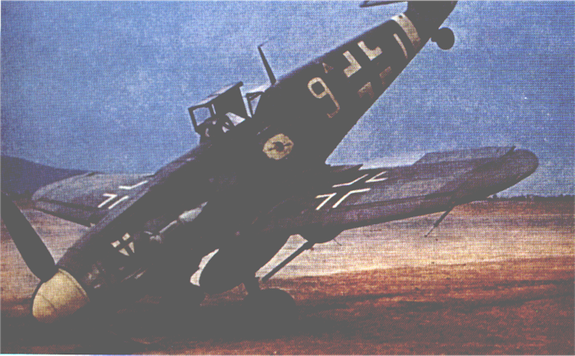
.
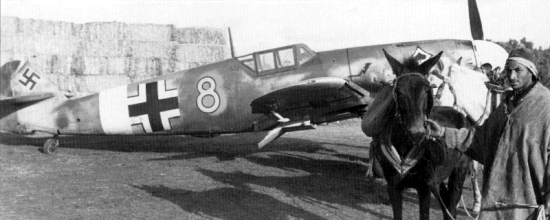
.
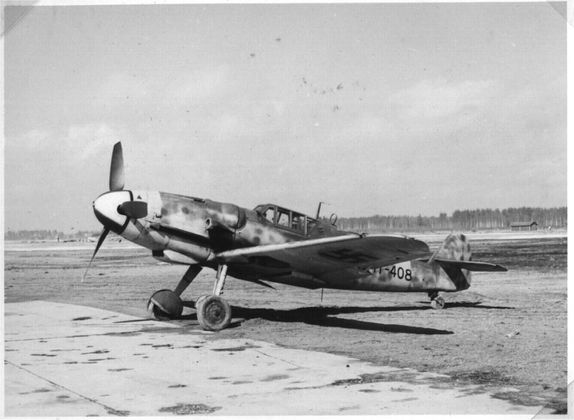
.
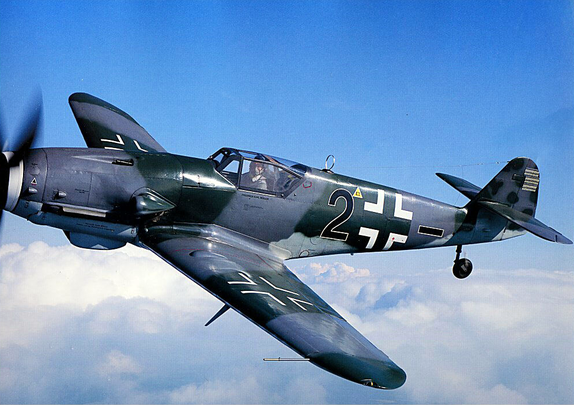
.
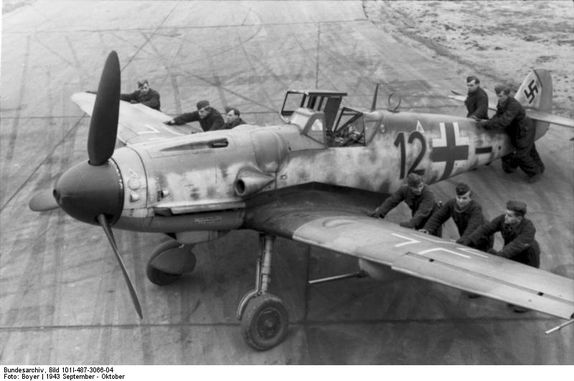
.

.

![]()

.
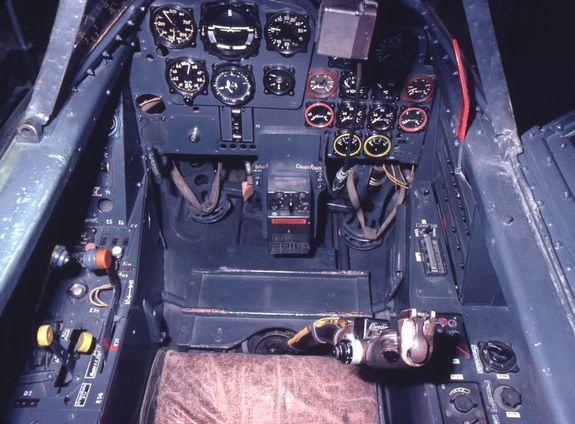
.

.
 .
.
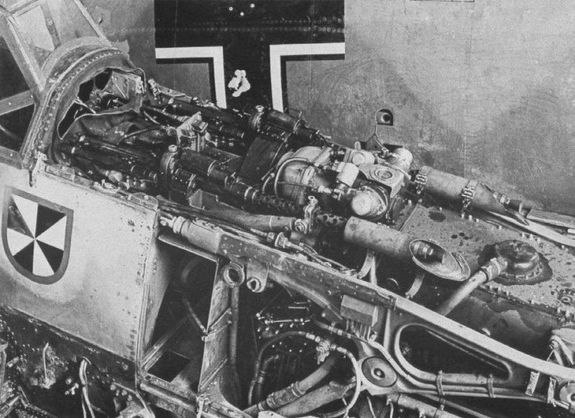
![]()


The highest scoring ace of all time was the great German Luftwaffe experte Erich Hartmann with 352 aerial kills. Flying Bf 109s (Me-109s) against the overmatched Soviet MiGs and Yaks for almost three years, he accumulated his unrivalled score. Hartmann claimed, that of all his accomplishments, he was proudest of the fact that he never lost a wingman. He is also reputed to have said. "Get close .. when he fills the entire windscreen ... then you can't possibly miss."
Hartmann was born in 1922, in Weissach, Wurttemberg. At age 19 (1941), he joined the Luftwaffe and was posted to Jagdgeschwader 52 (JG 52) on the Eastern Front in October, 1942. He scored his first kill in November, and only achieved his second three months later. In the first half of 1943, he worked out some of the tactics which would prove so successful later on. If he was attacked from behind, he would send his wingman down low and out in front. Then he would get behind the enemy and fire a short, quick accurate burst, waiting "until the enemy aircraft filled the windscreen." He would normally content himself with one victory; he was willing to wait for another day. His natural talents began to tell: excellent eyesight, lightning reflexes, an aggressive spirit, and an ability to stay cool while in combat.
As JG 52 retreated along with German ground forces in 1943, Hartmann's score began to mount. The great Kursk offensive, Operation Zitadelle, began on July 5. The Luftwaffe planned to screen the Wehrmacht's panzers from the Soviet Il-2 Sturmoviks, armored tank-busting aircraft, armed with twin 37mm cannon. Hartmann's Staffel 7 of JG 52 moved up to Ugrim, only 14 kilometers behind the front. As the Panther and Tiger tanks moved up, Junkers Ju.52 transports flew in supplies. On the morning of the 5th, four of Staffel 7's pilots did not return, apparently their compasses misled them, due to extraordinary iron ore deposits in the area. Hartmann was promoted to Staffelkapitan on the spot. The offensive ground forward slowly on the 6th and 7th; obviously the Russians had dug in and prepared defensive lines in depth.
On the morning of July 7, 1943, sun rose over Ugrim in the northern Ukraine about 3AM. Staffel 7's Me.109 G10's lay scattered around, in the deep grass of the Ugrim airfield. Hartmann's personal plane, decorated with a large Roman numeral 'I' and the name Usch in a red heart. (Usch Paetch was his fiancee, whom he wrote to daily.) In the comfortable summer weather, the pilots slept in tents.
On waking, Hartmann dressed in a gray shirt, blue-gray trousers, and gray shoes. He washed up and shaved in a small stream and ate breakfast, two eggs, cooked by a couple of Russian girls. He and the other three pilots in his Schwarm were assigned to cover an F.W.189 on a dawn reconnaissance mission.
Erich joked with his crew chief, 'Bimel' Merten, and strapped himself into the cockpit. At 3:04, the recon plane started and Hartmann set Messerschmitt's flaps and checked the fuel while Merten cranked the starter.
The DB 605's twelve cylinders coughed, belched smoke, and then caught smoothly. His three comrades followed him to the take-off spot. He gunned the engine while stomping on the brakes. When he released them, his 109 shot forward and quickly reached 160 km/hour. He gently pulled back on the stick and was airborne; the other three followed him closely. They all banked left as they went through post-take-off routines: retract landing gear, close radiator flaps, ease back on the throttle, and check gauges, guns, and gunsight.
They climbed to 1300 meters as they flew northeast and then swung southward, with the Fw 189 in view. The flight proceeded uneventfully and the recon plane headed for Ugrim. Hartmann's radio crackled with a report from Adler, the German forward spotting post; a group of ten to twenty Russian planes were headed west. Hartmann throttled up a bit, gained altitude, and turned his Schwarm toward the east without sighting anything for several minutes.
Soon enough, many large Il-2's came into view. With its armor and rear gunner, the Sturmovik was a tough target. With the Sturmoviks closing head-on, Hartmann unhesitatingly ordered an attack. He dived down below them, picking up airspeed, then banked around and came up behind and beneath them, aiming for his target's vulnerable ventral oil radiator. The Il-2's flew straight on.

Hartmann's Bf 109 roared along, doing over 400 MPH; Hartmann streaked into a Sturmovik's blind spot. At 200 yards, its wingspan filled his gunsight ring; still he closed in to 150, then 100 yards before firing. He briefly triggered his 20mm cannon and his two 12mm machine guns, for about one and a half seconds, before his speed carried him in front of them. As other Bf 109s struck their targets, Hartmann glanced back and saw blue flames and black sooty smoke streaming from the Sturmovik's radiator. His twenty-second victory of the war.
Under the deadly attack of the Messerschmitts, the formation of Russian airplanes began to break up. Having regained altitude, Hartmann again zoomed down below the tail of an Il-2. He checked his own rear and stabilized his aircraft. This Russian pilot, alerted to the danger, spotted him and turned sharply to evade. The young blond ace matched the turn and instantly estimated the lead needed for a deflection shot. At 150 meters, he opened fire, and his bullets tore into the side of the Russian tank-buster. More blue flame and black smoke poured from his twenty-third victim's oil radiator.
As the remaining scattered Russian planes fled eastward, Hartmann radioed his Staffel to return to Ugrim.
About 4AM, as they approached the field, Hartmann waggled his wings twice, indicating his two victories. On landing, Mertem and other ground crew gathered around him, offering congratulations. Hartmann walked to the operations tent to file his Gefechtsbericht, his after-action report. Early reports from the Adler posts already showed more Russian air activity than on the 5th or 6th. Four pilots sat in their planes, ready to take-off in less than a minute. Hartmann soon fell asleep by his own machine. But only briefly.
By 5:50, he was back in the air, leading a flight of 109s on a frei chase, and he soon found more Il-2s, escorted by fighters. The Messerchmitts attacked successfully, with Hartmann downing another Il-2 and an LaGG-3 fighter. Within an hour, he was back on the ground, with four victories for the day.
Late that afternoon, he led the Staffel up again, to the northeast. They found a group of Soviet LaGG-3 fighters, which they engaged in a sprawling dogfight. It was over quickly and Hartmann had shot down three enemy fighters, making it seven for the day, his largest score so far.
He reached 50 by August of 1943. Within the month, he had reached 80, and was promoted to lead 9./JG52. Earlier in the war, 25 or 50 victories would have earned a German fighter pilot the Knight's Cross. By late 1943, Hartmann had to down 148 before he earned his Knight's Cross. By March 2, 1944, he had reached a total of 202, earning him the Oak Leaves. He was the fourth Luftwaffe fighter pilot to reach 250, the first to reach 300, and the only one to reach 350.
He was awarded the Third Reich's highest regularly awarded military decoration: The Knight's Cross to the Iron Cross with Oak Leaves, Swords and Diamonds. With apologies to any German readers of this page, I must say that only the Germans could come up with a name like that: "Das Ritterkreuz zum Eisernen Kreuz mit Eichenlaub, Schwertern und Brillianten".
To be accurate, the highest military decoration was "The Grand Cross to the Iron Cross." It was only awarded once to Hermann Göring. The second highest military decoration was "The Knight's Cross to the Iron Cross with Golden Oak Leaves, Swords and Diamonds" and was also awarded only once to the Stuka ace Hans-Ulrich Rudel. Thus, Hartmann's medal, "The Knight's Cross to the Iron Cross with Oak Leaves, Swords and Diamonds," was, to be precise, the third highest German military decoration through WW2, was awarded to 27 soldiers, 12 of whom were Luftwaffe pilots.
![]()

![]()

![]()


![]()

Luftwaffe Hauptmann (Captain) pilot FW-190,Germany 1944
01 - LKp N101 headphones
02 - Nitsche & Günther Fl. 30550 goggles
03 - Drager model 10-69 oxygen mask
04 - Hankart watch
05 - AK 39Fl. compass
06 - 25 mm Walther Flarepistol M-43 with ammo belt
07 - holster
08 - FW-190 parachute
09 - aviation boots
10 - M-37 Luftwaffe breeches
11 - Luftwaffe leather jacket with Hauptmann's insignia and Luftwaffe armband
Luftwaffe in Action - Air War over Europe 1943-44
Luftwaffe - Part 1 / Warbirds of WWII Series
Luftwaffe - Part 3/ Warbirds of WWII Series
![]()

![]()





















/idata%2F0396584%2FKOREA%2F71910_korea_MIA1_800.JPG)
/idata%2F0396584%2FU.S.ARMY-POST-WW2%2Fphot4901a.jpg)
/idata%2F0396584%2FDRAWINGS-UNIFORMS-WW2%2F30-451-09b-2.jpg)
/idata%2F0396584%2FP-40%2F44FS000.jpg)
/idata%2F0396584%2FGERMAN-U-BOAT%2FBundesarchiv_Bild_101II-MW-1031-28-_Lorient-_U-31.jpg)
/idata%2F0396584%2FSOVIET-ARMY-WW2%2F1.jpg)




